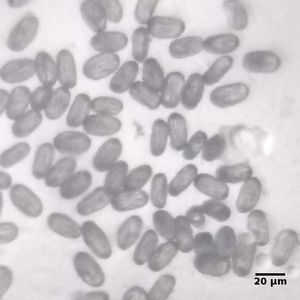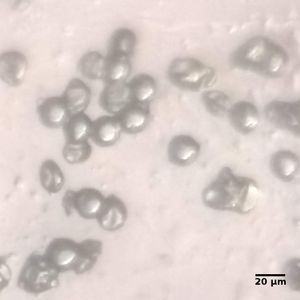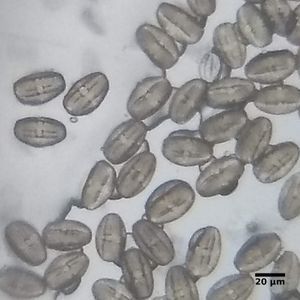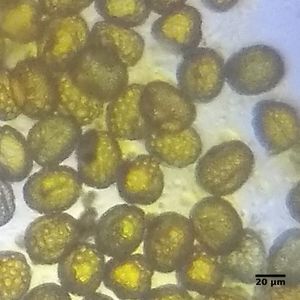Fern spore catapult
 Jun 02, 2018 • 10:44 AM UTC
Jun 02, 2018 • 10:44 AM UTC Unknown Location
Unknown Location 140x Magnification
140x Magnification Microorganisms
Microorganisms
varuni
Learn about the author...
21posts
22comments
1locations

I planted a fern in my garden a couple of months ago and ferns have been taking over!


I’m not sure about the species — Ostrich fern ( Matteuccia orientalis )?
I remember learning about fern reproduction involving some strange alternation of generations with ‘spores’ that grow on the underside of leaves. Sure enough, there were a tonne of these on the plant:
I remember learning about fern reproduction involving some strange alternation of generations with ‘spores’ that grow on the underside of leaves. Sure enough, there were a tonne of these on the plant:

So I brushed some cello tape on these ‘spores’ and looked at them under the Foldscope. I saw these centurion helmet like things:


The whole object is about 110 microns in diameter and the mohock like thing is about 20 microns in width.
I could hardly remember what was n or 2n or sporohytes or gametes: so I dug out my botany textbook from college to refresh my memory.
I could hardly remember what was n or 2n or sporohytes or gametes: so I dug out my botany textbook from college to refresh my memory.

Ferns are part of a clade (that was) called Pteridophyta . The leaves that you see are the 2n generation. On the underside of leaves, they form sori (singular: sorus) that are a collection of sporangia (singular: sporangium). Each sporangium consists of a stalk with a capsule which holds spores: the gametophyte generation (n). (Reference: Biology of Plants by Raven et. al. )
So these centurion helmet like things were the sporangium, the site of meiosis: going from 2n to n! If you look closely you can see the bean shaped spores (n) that have come out of some of a sporangium:
So these centurion helmet like things were the sporangium, the site of meiosis: going from 2n to n! If you look closely you can see the bean shaped spores (n) that have come out of some of a sporangium:

(spores = 25 – 30 microns)
The really interesting thing I learnt is how the sporangia disperse the spores. The layer of wall cells (the mohock on the helmet) is called an annulus. As the sporangia dry out, these cells dehydrate and shrink, causing the sporangia to suddenly break open at the thiner walled ‘lip cells’. However, this burst is NOT what releases the spores, its the snapping back of the annulus to its original position that catapults the spores away!
So I went back to the slide I made earlier in the day, and it did seem like many more of the centurion helmets had split open and catapulted their spores out since I made the slide:
The really interesting thing I learnt is how the sporangia disperse the spores. The layer of wall cells (the mohock on the helmet) is called an annulus. As the sporangia dry out, these cells dehydrate and shrink, causing the sporangia to suddenly break open at the thiner walled ‘lip cells’. However, this burst is NOT what releases the spores, its the snapping back of the annulus to its original position that catapults the spores away!
So I went back to the slide I made earlier in the day, and it did seem like many more of the centurion helmets had split open and catapulted their spores out since I made the slide:


I wanted to see if I could catch one of these catapults. I tried to dehydrate them by heating: charging my phone (it gets hot for some reason when its charging), turning on the torch feature and, for good measure, also putting it under a table lamp:
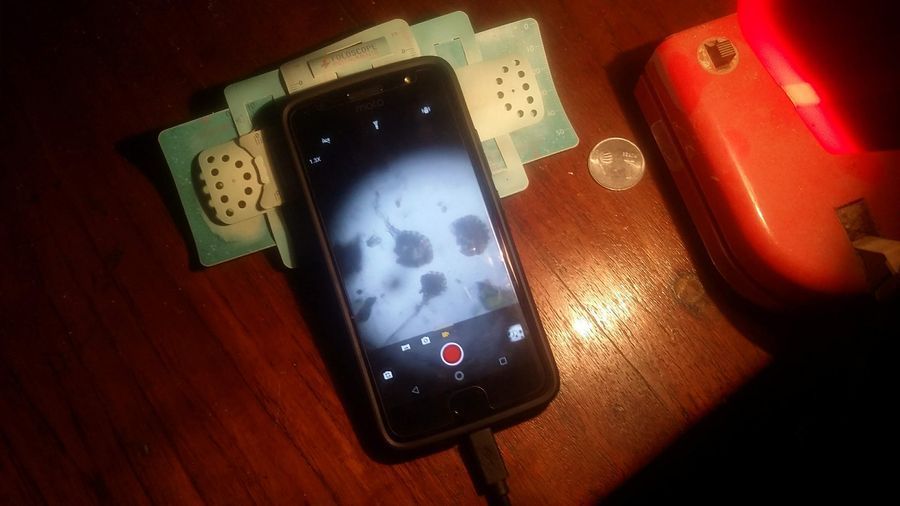
I found a sporangium that I thought was almost ready to catapult its spores out and focused in on it. I tried to record it on and off (my phone complained about constant recording and overheating). I haven’t seen the catapult effect yet. (Will update here if/when I do…)
In the meantime, I also looked for the growing gametophytes: what the spores grow into (n) and where the gametes actually meet and form the zygote (2n) that will grow into a sporophyte. New ferns grow out of these structures. But I think most of these young ferns I saw are from vegetative reproduction:
In the meantime, I also looked for the growing gametophytes: what the spores grow into (n) and where the gametes actually meet and form the zygote (2n) that will grow into a sporophyte. New ferns grow out of these structures. But I think most of these young ferns I saw are from vegetative reproduction:

I’ve “planted” some of the sori in a pot. I’ll report back if they sprout into full gametophytes.

But just I couldn’t get enough of the BEEEAUUTIFUL sporangia!
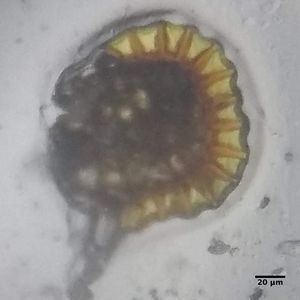

(In the the second image, you can see a top and opened out view of the sporangium.)
The colour was a lovely amber that I don’t think the phone camera was able to quite capture. Too see it, you will have to find a fern and look at the sporangia yourself!
The colour was a lovely amber that I don’t think the phone camera was able to quite capture. Too see it, you will have to find a fern and look at the sporangia yourself!
Sign in to commentNobody has commented yet... Share your thoughts with the author and start the discussion!
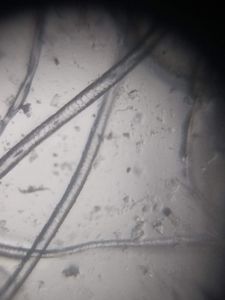
 0 Applause
0 Applause 0 Comments
0 Comments
